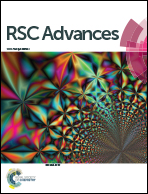Ultrafast single-droplet bouncing actuator with electrostatic force on superhydrophobic electrodes†
Abstract
The ultrafast bouncing motion of a liquid droplet has been investigated for droplet manipulation with a single droplet actuator using an electrostatic force for the first time. Under an electrostatic field, various kinds of liquid droplets (e.g. deionized water and poly(3,4-ethylenedioxythiophene) polystyrene sulfonate (PEDOT:PSS) solution) were rapidly bounced between two superhydrophobic electrodes, one from a capacitive electrode and another from a stage electrode. They were formed by sequential processes of a galvanic displacement method and the coating of a self-assembled monolayer on circular-patterned Cu films on a printed circuit board substrate. The frequency of the bouncing motion of the droplets reached up to 0.57 kHz and 0.71 kHz for water and PEDOT:PSS solution, respectively. Furthermore, the effects of the droplet volume, different types of liquid material such as water and conducting polymer solution, and applied voltages on the droplet bouncing motion were fully analyzed. A charge transfer between the droplet surface and the super-hydrophobic electrodes leads to droplet bouncing and its repetitive charging/discharging process across two electrodes results in a continuous bouncing operation. We successfully measured the transferred current of nA level from several single droplets under rapidly-bouncing motion via the stage electrode. This rapidly-bouncing droplet actuator using electrostatic force can be effectively used for various chemical and biological applications due to its high-speed, contamination-free and facile method.


 Please wait while we load your content...
Please wait while we load your content...